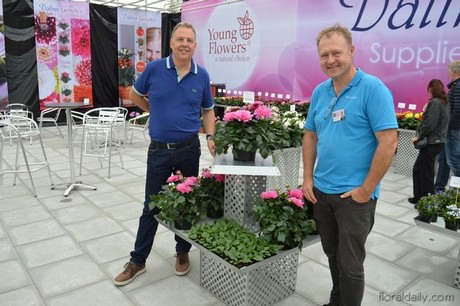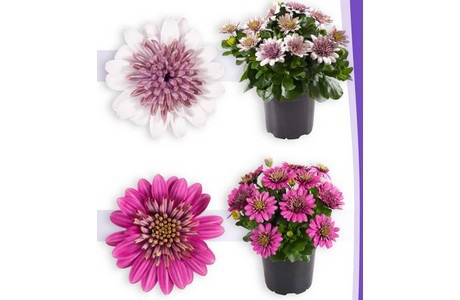
Michael Ellegaard of Young Flowers and Hans Henrik Kampmann of Dalina Genetics at the FlowerTrials 2016. They are standing next to the Dahlia Maxi “cv. Mendoza”. Young Flowers and Dalina Genetics are cooperating for 19 years now. Dalina is specialized in plant breeding of gentianas, dahlias, and osteospermum and is also active in pot vegetables. Young Flowers is responsible for the sales of the rooted and unrooted cuttings and seeds.
Dahlia Maxi
The dahlia mentioned above is the Dahlia Maxi. It is the largest Dahlia series of Dalina Genetics and they added this new segment to their Mini and Midi varieties about 15 years ago. According to Kampmann, the Dahlia Maxi's are stronger and have bigger flowers. "They flower for like three months and the diameter of these flowers are 10cm and can go up to 15 cm when thriving", says Kampmann.
The Dahlia Midi is still the most demanded product of the Dahlias by the consumers, but the Dahlia Maxi seems to - finally- get traction in the market. "In the beginning, it was a new product and people were not aware of the product and its advantages. They had to try it out first and experience how the variety performs. However, this "trying out" was the most difficult and time-consuming step as the Maxi was (and still is) more expensive than the Midi, because it is a larger and more exclusive product. But, when the consumer experienced the plant on their patio, they often choose this variety again." But this process took a while. "After introducing the Dahlia Maxi, it took about seven years till the market recognized the product and started to buy it. Now, eight years later, it is a popular plant in Western Europe, Japan, Korea, India and China and the demand is still increasing."

Dahlia Maxi. Mendoza Dahlia Maxi Cancun
Over the years, Dalina Genetics added new colors and kept and still is investing in enhancing the habits of the plant - like fast growing, uniformity and compactness. At the moment, the assortment consists of 16 colors and Kampmann expects to have over 20 colors in two to three years. "All over the world, we see a demand for the bi-colored varieties. We already have all the main colors, so the new varieties will therefore be bi-colored ones."
In the future, Kampmann expects that the Dahlia Maxi will expand its market share. "I'm sure it will consume from the Midi's and will take a chunk from that share. However, the Maxi's are a more exclusive and therefore more expensive product than the Midi's. Therefore, the Midis will remain important varieties."
Osteospermum Paso Doble
The Osteospermum Paso Doble, on the other hand, is one of the novelties in Dalina Genetic's assortment and is known for the fact that the flower does not closes in the afternoon. "The traditional osteo has the tendency to close and this is the disadvantage of the variety. Then, a double flowered osteo came on the market and this variety could not close. This was a big plus for the consumer perspective", he says.
In 2015, Dalina Genetics introduced its double flowered variety; Paso Doble and this has been introduced in an -as Kampmann calls it- existing segment. "We were not the first that introduced this variety, but we were able to enhance the habits of the variety", says Kampmann. "The first double flowered osteos were weak plants and required a different treatment then the single flowered osteos. After years of breeding, we developed the Paso Doble that can grow together with the single flowered varieties. Additionally, the Paso Doble is practically sterile, as it doesn't has pollen, a flower can last for like two weeks and can take about minus 5 degrees frost and the plant can go on and on."

The current assortment of the Paso Doble consists of two colors; white and purple. According to Kampmann, two more colors are coming up, which will be in small trials in 2017. Also these varieties will probably be bi-colored ones.
Unlike the Dahlia Maxi, this osteo has been adapted in the market quite fast. Since its introduction in 2015, the demand increased sharply and at the moment, it is a popular plant in Northern Europe. "The product or actually the product segment has been on the market for many years. We add a new (improved) variety to this segment, which only expands the range of products for the consumer to choose from. It is not the same as the Dahlia Maxi because there are no large price differences between the products in the segment." The demand for the double varieties is still increasing and in the end, Kampmann expects the double osteo varieties will take a significant percentage of the Osteo market.
For more information
Young Flowers A/S
Michael Ellegaard
Email: [email protected]
www.youngflowers.dk

Dalina Genetics® A/S
Hans Henrik Kampmann
Email: [email protected]
www.dalina.dk
